How Long to Thaw a Frozen Turkey
Here is a truth not often acknowledged: if you don’t thaw your turkey correctly, you won’t have a successful turkey cook. And while thawing methods abound, there’s only one way to be sure your turkey is thawed correctly for Thanksgiving—or any other day! Read on for the thermal tips needed to plan the thawing of your turkey and to make sure you do it safely.
Check your turkey thaw with an instant-read thermometer
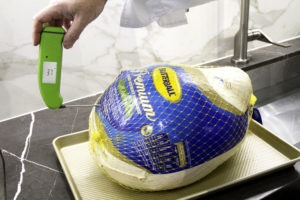
Making sure your turkey is thawed through is important for proper cooking. Use an instant-read thermometer, like our Thermapen® ONE, to verify your turkey’s internal temperature in multiple locations before putting it in the oven. It should be above 32°F (0°C) That’s right, you measure the temperature of your turkey before you cook it!
⚠ Never Cook a Partially Frozen Turkey
While you can actually cook a fully frozen turkey and you can absolutely cook a thawed turkey, you SHOULD NOT cook a turkey that is only partially thawed (and therefore partially frozen). If the turkey meat is not at a uniform temperature before you cook it on Thanksgiving morning, you’re asking for disaster.
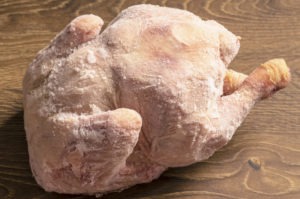
The steep temperature gradients that exist in a partially frozen turkey—from a cold icy center up to the perfectly thawed exterior—will cause the turkey to cook unevenly. By the time that cold center is fully cooked, the outer layers of the breast will be dry and overdone.
Turkey must be kept at a safe temperature during “the big thaw.” While frozen, a turkey is safe indefinitely. However, as soon as it begins to thaw, any bacteria that may have been present before freezing can begin to grow again.
—Kathy Bernard for the USDA, “The Big Thaw For Thanksgiving”
The Best Method: How to Defrost a Turkey in the Fridge
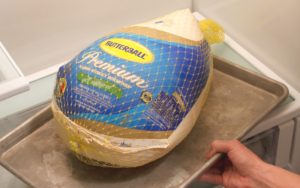
The best way to thaw a turkey is to place it in the refrigerator (set to 37°F [3°C]) on a sheet pan with the breast side up. Your turkey will thaw gently and evenly.
How long will it take to thaw a turkey in the refrigerator? 24 hours for every 4-5 pounds (1.8-2.3 kg). That means a 16-pound turkey will take about 4 days to thaw in the fridge. In the end, this method requires the least hands-on labor, but it does take the longest.
The length of time it takes means it’s a good idea to buy your turkey on the Saturday or Sunday before Thanksgiving. Then, put it on the pan on the bottom shelf of your fridge (so that if anything drips off of it, you don’t get cross-contamination) until you’re ready to cook on Thursday. If you’re planning on a very large turkey, give it a week to be safe.
Don’t worry that the turkey will thaw early if you buy a smaller one. A thawed turkey can stay fresh in the refrigerator for at least 3 days.
Fastest Way to Thaw a Turkey: a Cold Water Bath
Of course, if you don’t get your turkey in time, you can use the speed method.
Because of it’s greater molecular density, water is better at transferring heat to and from things than air is. If you need to thaw your turkey faster than in the fridge, you can thaw it for at least 30 minutes per pound. (A 20-pound [9.1 kg] turkey takes as little as 10 hours to thaw like this.)

Thawing a turkey in a cooler or bucket
- Put your wrapped turkey breast-side down in a cooler or large bucket. And fill it with cold water to cover it. It will probably float until it is thawed.
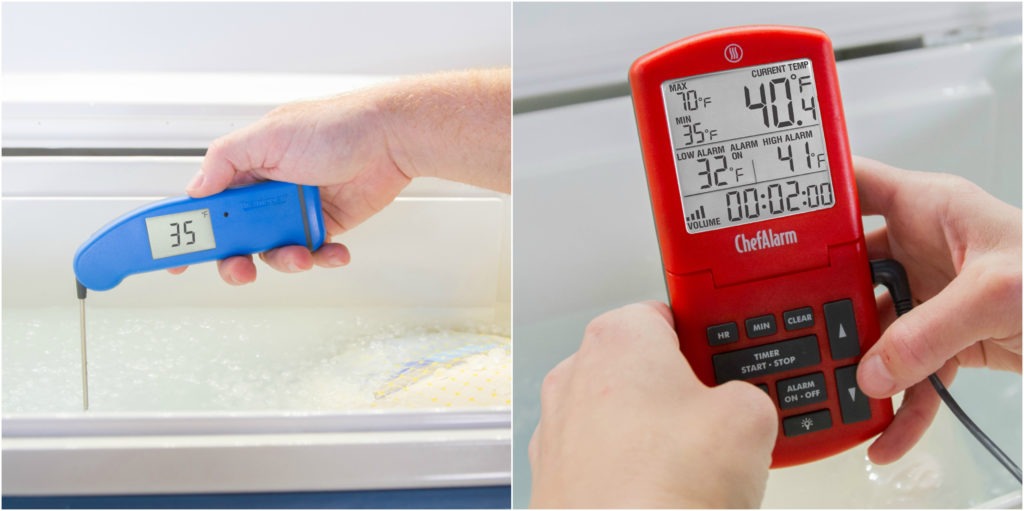
- Put the probe of an alarm thermometer (like the ChefAlarm®) in the water, with the high-alarm set to 41°F (5°C). If the alarm sounds, your water is getting too warm—ice it!

- If you don’t have a leave-in probe thermometer, spot-check the water temp every half hour with an instant-red thermometer like the Thermapen®. Again, add ice if the temperature gets over 40°F (4.4°C).
- This process can easily take 1-2 bags of ice, so have it ready on hand in case the temperature gets too high. A rise above 40°F (4.4°C) can allow growth of potentially pathogenic bacteria.

- A 20-pound (9.1 kg) turkey will 10 hours to thaw using the cold water method.
If you have and extra refrigerator, you can put the turkey bucket with water in the fridge, keeping the door closed, to maintain a proper water temperature. If you’re using a cooler, leave the cooler lid closed unless your alarm alerts you to the need for more ice.
Thawing a turkey in the sink
Can you thaw your turkey in a kitchen sink? Yes, but with great care.
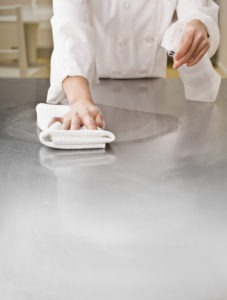
- Thawing in a sink is like thawing in a bucket. You must keep the water cold by feeding it ice, but you must be very careful not to let any of that icy turkey-water to splash onto any other work surfaces. Use anti-bacterial wipes or cleaner to take care of any splashes. Also use a disinfecting cleaner in the sink after you drain it.
- Use a ChefAlarm to monitor the temperature in the sink. Don’t let it get above 40°F (4.4°C). Drain some water and add ice if the temp creeps above that mark. Attach the probe to the edge of the sink to keep it from being submerged or use the Pro Series® Waterproof Needle Probe and throw it on in the sink.

- Again, if you don’t have a leave-in probe thermometer, you can check the temperature of the water every half hour with a Thermapen. This can be a bother, but if you didn’t thaw your turkey in time, but it’s better than having an improperly cooked turkey!
Verifying A Proper Thaw for Your Turkey

To make sure your turkey is properly thawed, take its temperature. Stick the tip of your Thermapen right through the wrapper and deep into the breast in several places. Look for a temperature no lower than 30°F (-1.1°C) and no higher than 40°F (4.4°C).
Watch the display as you move the probe tip through the turkey meat: the lowest reading is the most important for the thaw.
➤If you find a temperature lower than 30°F (-1.1°C), keep thawing!
⚠How Not to Thaw a Turkey
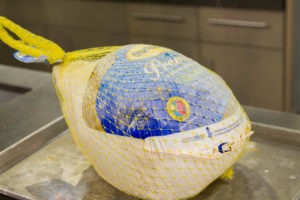
Do not thaw your turkey by leaving it on the counter, on your porch, or in your garage overnight exposed room temperatures. Leaving your turkey to thaw in this manner will leave the outer layers of the meat exposed to the Temperature Danger Zone (40-140°F [4.4-60°C]). For periods that are long enough to encourage bacterial growth. Don’t do it!
Dry Surface = Crispy Skin
Lastly, thoroughly dry the surface of the turkey before cooking it. Water on the surface of the meat will slow down the cook, and cause uneven browning. Plus, if the turkey is wet, the heat of the oven or smoker must first work to evaporate the surface moisture before the cooking really begins.
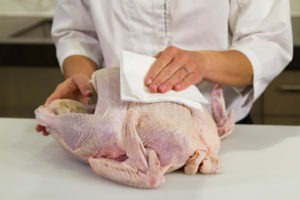
➤ Pat your turkey dry with paper towels right before cooking.
This is particularly important if you will be brining your turkey (soaking it in saltwater). Be sure to get the entire surface of the turkey (even the inside surface of the main cavity and neck cavity) nice and dry before seasoning. Then, slather on the butter or oil and spices (whatever your recipe calls for) and start cooking.
Extra Credit
If you want extra crispy turkey skin, a little extra planning and effort up front can pay real dividends. Air-drying, or leaving your turkey uncovered in the refrigerator for the morning (8 hours) or the entire day before (24 hours), will help produce a crispier skin.
Turkey Thaw Day
At ThermoWorks we call the Saturday before Thanksgiving “Turkey Thaw Day.” If you put your turkey in the refrigerator on this day (November 19th this year!), it should be thawed to perfection by the time you need to cook it. And don’t worry about it thawing too soon. It can stay in the fridge, thawed, for 3-4 days without any problem. (We can text you a reminder to take your turkey out of the freezer. Sign up for the reminder here.)
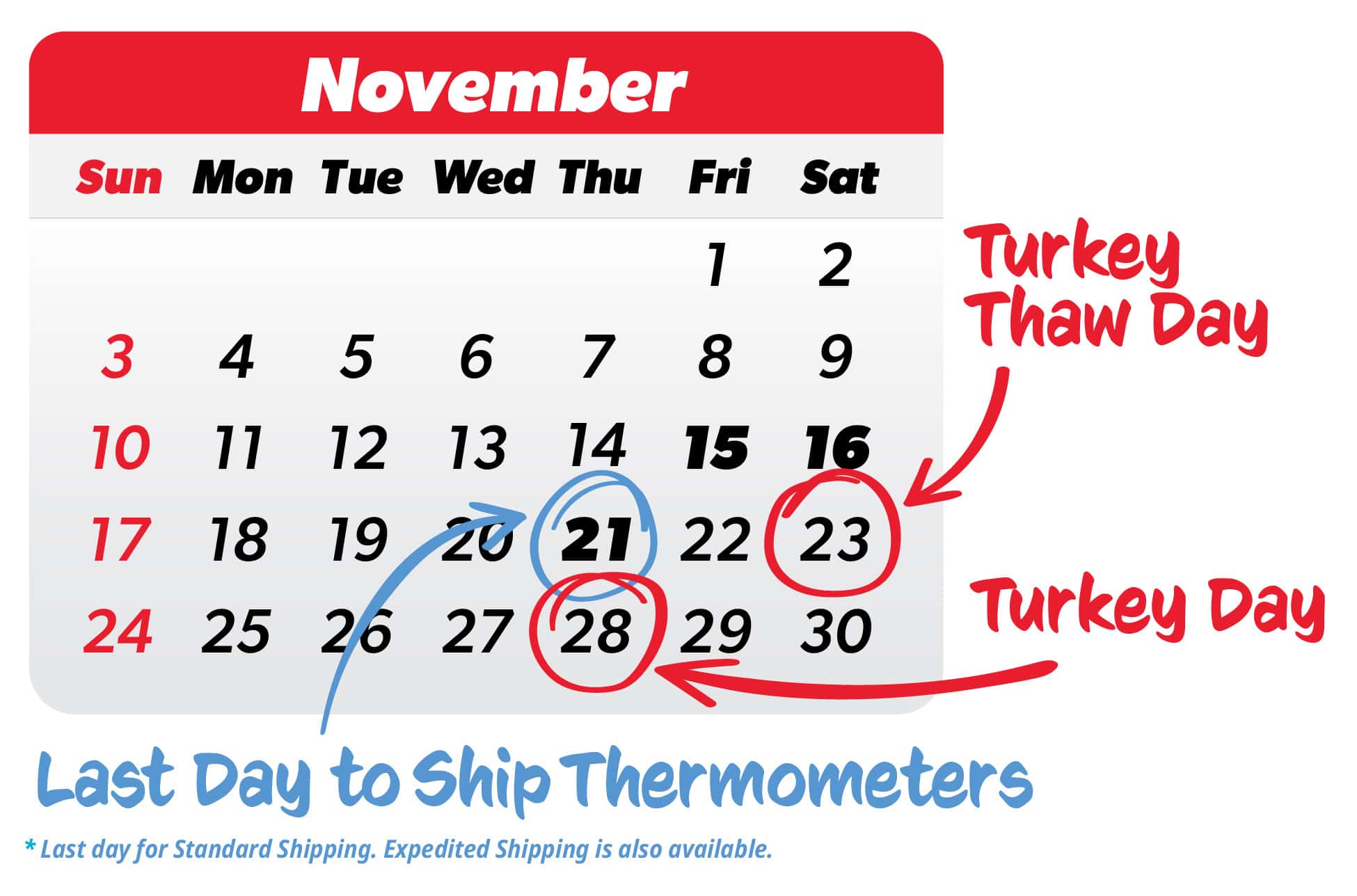
Learn more about turkey with our other important turkey tips…
Turkey Temperature Tips: The Quest for the Perfect Turkey
Master the critical turkey temperatures: be your family’s Thanksgiving hero this year!
Shop now for products used in this post:


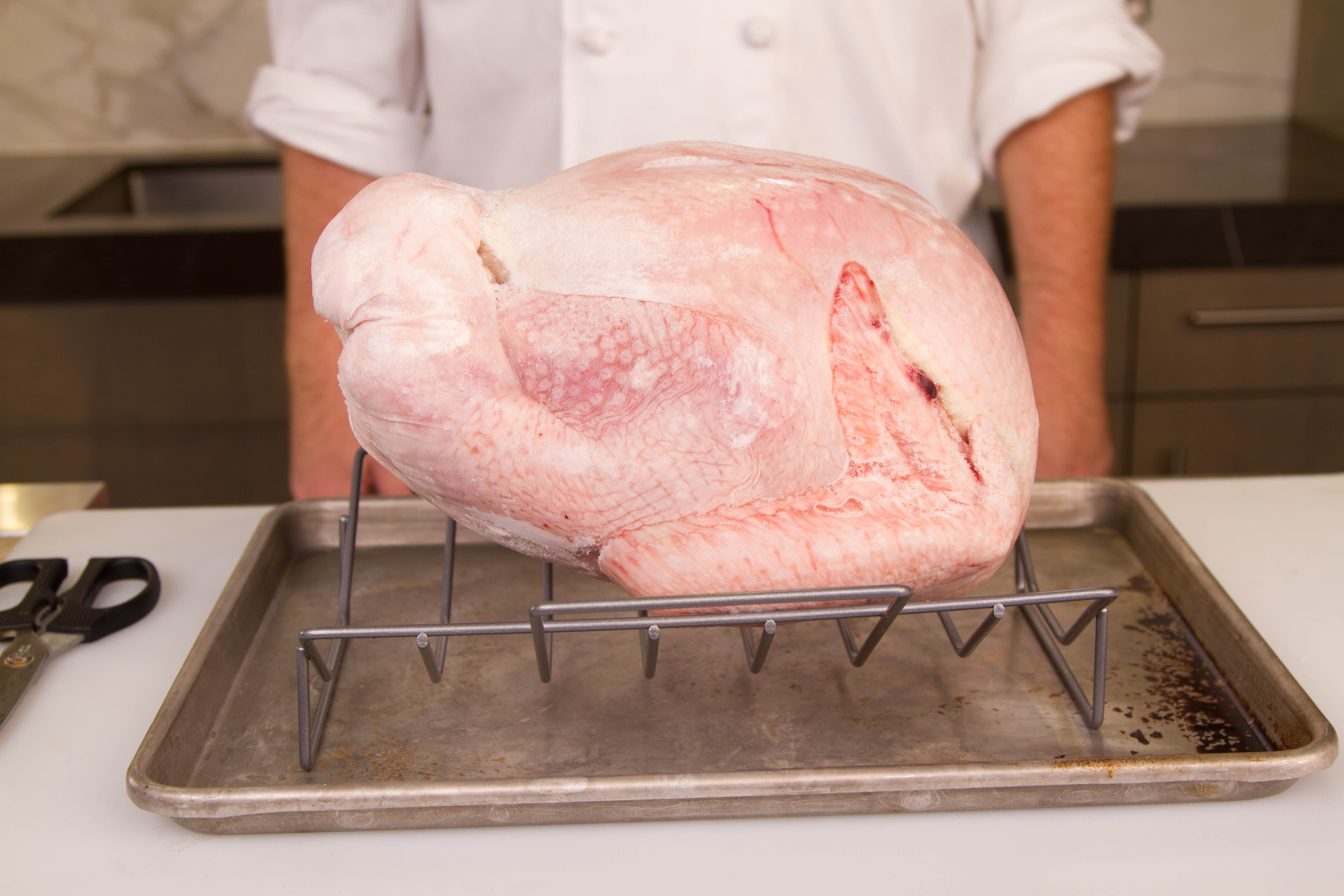
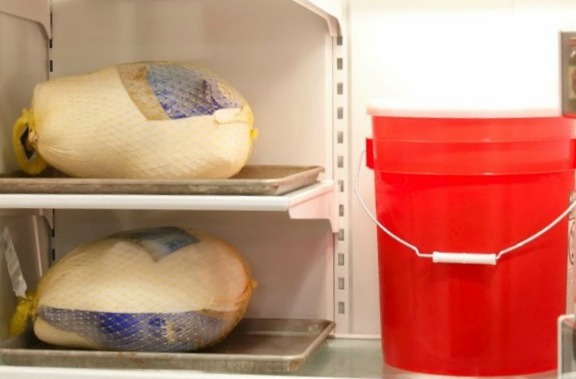
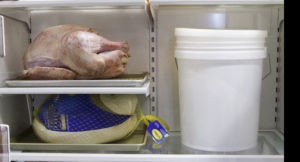 If you have and extra refrigerator, you can put the turkey bucket with water in the fridge, keeping the door closed, to maintain a proper water temperature. If you’re using a cooler, leave the cooler lid closed unless your alarm alerts you to the need for more ice.
If you have and extra refrigerator, you can put the turkey bucket with water in the fridge, keeping the door closed, to maintain a proper water temperature. If you’re using a cooler, leave the cooler lid closed unless your alarm alerts you to the need for more ice.

I have the M4k Thermapen and the Chef Alarm, and I seem to use them more and more every day, and I am thinking they might be perfect for a couple of Christmas stockings! I enjoyed reading your Turkey Tips 1 & 2 however I was disappointed to realise that those of us in Canada would not have the benefit of your remaining tips in time for our Thanksgiving holiday which was on October 10 this year.
Raymond,
So glad to hear your Mk4 and ChefAlarm are treating you well. We apologize for the oversight of our Canadian customers’ Thanksgiving holiday. Rest assured we’ll be more on top of things next year. I hope your Thanksgiving dinner was delicious!
-Kim
Your article above teased about cooking a frozen turkey, saying “more on that later” but there was never anything about it! Or did I miss it? I would love to know how this is done!
Jane,
We have a future blog post scheduled that goes over roasting a frozen turkey. Keep track of all our holiday content in November.
Thanks!
-Kim
I bought a frozen (10 lb.) turkey this past Friday, and thanks for letting me know how long I have to let it thaw, in the ‘fridge. (My 4 dogs and I will be eating turkey forever).
11.5 lb frozen turkey purchased afternoon of November 21. Placed in fridge to thaw. Removed November 26 to brine. Temp at breast 42 and 41 at thigh. Will brine overnite and air dry 24 hours. Will this be safe to cook and eat?
Yes, it should be fine. I’m sorry I didn’t reply sooner!